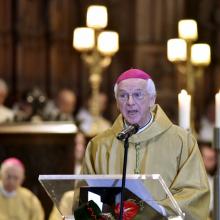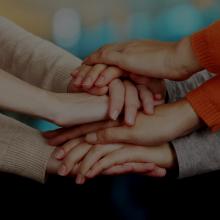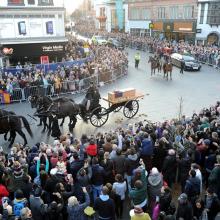Catholic

Image via Reuters/Jonathan Ernst/RNS
President Obama’s nominee for the Supreme Court, Merrick Garland, would be the current court’s fourth Jewish justice if confirmed.
For Jews, who represent about two percent of the population, holding 44 percent of the seats on the court might be a point of pride.
But is it anything more than that?
As word of the planned event circulated on social media it was even criticized by South African Cardinal Wilfrid Napier, who tweeted that it reflects “the disjuncture” between the call to teach the gospel and the “obsession” to be fair about moral issues. “Georgetown’s hosting Cecile Richards is an obvious case!” he said.
The Lecture Fund noted on its website that the event will be for members of the university community. “The event is not open to the public and only those with a Georgetown University ID will be allowed to attend,” it said.
Screenshot via The Late Show with Stephen Colbert/Youtube
“Are you challenging me to a Catholic throwdown?”
Thus commenced Stephen Colbert and Patricia Heaton’s Catholic-off on the Jan. 18 episode of the Late Show. The famously Catholic TV host wanted to give his guest a fighting chance though. So, he produced a family photo of Heaton’s family with approximately enough people to fill a village.

Image via Frank Gaertner/Shutterstock.com
Catholics and Lutherans have made another step toward joint commemoration of the 500th anniversary of the Reformation in 2017 by issuing common liturgical guidelines for ecumenical services to mark the occasion. The guidelines, in a booklet called “Common Prayer,” provide a template for an ecumenical service, complete with suggested prayers, appropriate hymns, and themes for sermons.

Arcchbishop Jozef De Kesel. Image via REUTERS/Eric Vidal/RNS
Belgium is embroiled in a religious freedom controversy after the new head of the country’s Roman Catholic Church demanded that faith-run hospitals and nursing homes have the right to refuse euthanasia to patients.
A 2002 law decriminalized euthanasia for terminally ill adults and it has the support of a large majority of public opinion and politicians. But opposition in this historically Catholic country has grown as lawmakers extended the practice to including terminally ill children and people with severe psychological problems.

Tom Molina-Duarte and Bryan Victor. Image via Eric Seals / Detroit Free Press / RNS
Because their Catholic faith is against same-sex marriage, Bryan Victor and Thomas Molina-Duarte made their wedding vows this summer before a Protestant minister in a Detroit Episcopal church.
Those in attendance included many family members, including Victor’s uncle, who is a Catholic priest and Macomb County pastor. The Rev. Ronald Victor did not officiate but was there because, he told his nephew, the Catholic Church “needs more examples of gay holiness.”
When Victor and Molina-Duarte attend Mass every Sunday, the couple go to a Detroit Catholic church, where Bryan Victor’s mom and dad join them in the pew. In their shared Catholic faith, Victor and Molina-Duarte find spiritual sustenance. And at their parish, they’ve also found acceptance.

People gather near a crime scene in Ciudad Juarez. Image via REUTERS / Jose Luis Gonzalez / RNS
Pope Francis will visit a prison and celebrate Mass in Ciudad Juarez, the Mexican border city plagued by violence in recent years, the Vatican has said in an announcement of details of the pontiff’s upcoming visit to Mexico.
The pope’s visit to Ciudad Juarez will conclude his six-day Mexico tour, starting on Feb. 12. The stop will draw attention to drug-related violence and the U.S. policy on migration.
While in the city on Feb. 17, Francis will tour a prison, meet with workers, and celebrate Mass at the fairgrounds close to the border. Around 220,000 people are expected to attend the Mass, with tickets offered to parishes on both sides of the Mexico-U.S. border.

The Rev. Jacques Mourad. Image via RNS
A Syrian priest held hostage for months by the ISIS terrorist group is certain his life was saved due to his interfaith work, despite being threatened with beheading by jihadists if he did not renounce Christianity.
The Rev. Jacques Mourad, a Syriac Catholic priest, was taken hostage in May from the Mar Moussa monastery, situated between the capital Damascus and the city of Homs. He and a volunteer from the monastery were forced into a car and driven for four days, during which time Mourad said he thought he would be killed.
“We could only perceive the sense of the desert. In that moment … I thought it was over,” he told members of Rome’s Foreign Press Association on Dec. 10, the first time he has spoken in detail about his odyssey since he escaped.

Image via BERNATSKAYA OXANA/Shutterstock.com
As he poured the gallon jug of kerosene over his head, onlookers reacted with disbelief. Before anyone knew what to do, he lit a match. In one terrible instant, 31-year-old Quaker Norman Morrison set himself ablaze in front of the Pentagon, just 40 feet below the 3rd floor window of Secretary of Defense Robert McNamara.
Moments before ignition, Morrison passed his 11-month-old daughter, Emily, to a bystander. His wife and two other children were in Baltimore that day, unaware of what this young husband and father had planned.
Though his terrifying act of self-destruction, Morrison brought the Vietnam War home to a country that was still largely unaware of the widespread atrocities taking place in Southeast Asia. It was hard for most Americans to comprehend the true human cost of U.S. carpet bombing, and the incineration of whole families in the name of peace and security. Even the U.S. military officials leading the war effort did not understand on a visceral level what it meant to burn human beings alive in Vietnam.
Norman Morrison provided a live demonstration.
Evangelicals don’t have a pope, or even a single spokesperson. We’re not a single denomination like the Catholic Church, so we lack a comparable hierarchical structure. Particular denominations have presidents or general secretaries, but no one human being serves as the representative figure of God on earth within the evangelical faith. Rather, following the teaching of Genesis 1:26-27, evangelicals believe all humanity bears the image of God. In fact, one of the functions of the early evangelical movement was to democratize the faith — to proclaim all humanity’s equal access to God through Jesus.
So, why did my heart shake with anticipation at the thought of being in this pope’s presence? Here’s why: More than any other person, since St. Francis of Assisi (his namesake), this pope has embodied the values and priorities of Jesus. He has shown us what it might have been like to walk the earth with Jesus himself — what it might have been like to watch him embrace the leper, to watch him defend the adulterous woman calling the Pharisees not to judge, to watch Jesus challenge the values and priorities of the religious establishment of his day. He has been a vision to watch.

trefalga / Shutterstock
EARLIER THIS YEAR Pope Francis titillated the world’s 1.2 billion Roman Catholics when he said we should not feel compelled to breed “like rabbits.” The Twitterverse resounded with commands to “hop to it.” The Italian press dubbed Francis’ speech the “Sermon of the Rabbit.”
In it, Pope Francis said, “Some think that—excuse the language—that in order to be good Catholics, we have to be like rabbits. No. Responsible parenthood.”
Was the pope changing Catholic teaching on birth control? On the contrary, Francis went on to underscore that “responsible parenthood” requires that couples regulate the births of their children, as Vatican teaching allows, using natural family planning methods.
What we think of as “the Catholic position” on contraception—“‘Every action which ... proposes to render procreation impossible’ is intrinsically evil”—was actually codified as official teaching in 1930 under Pope Pius XI and was part of a larger conversation in Christendom. At the 1930 Lambeth Conference, for example, the Anglican bishops approved a resolution stating: “In those cases where there is such a clearly felt moral obligation to limit or avoid parenthood, and where there is a morally sound reason for avoiding complete abstinence, other methods [of contraception] may be used, provided that this is done in the light of the same Christian principles.”
In 1951, Pope Pius XII overtly accepted natural family planning as a moral form of regulating births, in limited circumstances, within Christian marriage. He also emphasized the importance of a mature and informed conscience in moral reasoning. “It is correctly argued,” he wrote, “that the true meaning of adult independence is not to be led like a little child.”
As part of the process around the Second Vatican Council, Pope Paul VI oversaw a commission to examine the use of oral contraceptives in light of church teaching. The commission’s report—titled “Responsible Parenthood”—argued for the use of artificial contraception within Christian marriage. In the end, Pope Paul VI rejected the commission’s recommendation, and his 1968 encyclical Humanae Vitae reaffirmed the church’s teaching against artificial contraception.

Image via Africa Studio/Shutterstock
Pope Francis will be arriving in Washington, D.C., tomorrow, and we locals are getting ready for a huge celebration. Public officials have warned us to avoid travel for the next few days. We’re expecting the roads and public transportation to be flooded with thousands of pilgrims making their way to see the head of the world’s largest Christian communion. It’s gonna be a beautiful mess!
The pontiff's visit to the United States will be an enormous spectacle. I have no doubt that many will find it inspiring and uplifting. But what’s the ultimate impact? Could his time in the U.S. make waves that go beyond traffic delays and photo ops?
Here are three reasons that the pope’s arrival could mark a tipping point for American culture.
A new survey released from Pew Research Center, conducted in the lead-up to the pontiff’s visit, examined U.S. Catholics’ attitudes on family, marriage, and sexuality, as well as on issues close to the pope’s heart — concern for the poor, care for the environment, and forgiveness of sins. The results found Catholics “remarkably accepting of a wide variety of non-traditional families.”
This is not to say longstanding church teaching on marriage has changed — the church very much still upholds lifelong heterosexual monogamous marriage with children as the divine plan for coupleship, and nine-in-ten U.S. Catholics say this is the ideal arrangement. But large majorities now say other familial arrangements are acceptable, too.
According to the survey of U.S. Catholics, 85 percent say it is acceptable for a man and woman to live together as a couple outside of marriage, and 84 percent say it is acceptable for raise children in this arrangement. Two-thirds say it is acceptable for same-sex couples to raise children. And 70 percent say married couples who choose to not have children are choosing a lifestyle that is just as good as any other.
The findings show that as many as 45 percent of Americans will look at the church brand on the sign out front — Catholic or Baptist or Methodist or whatever — and drive past, thinking it is “not for me.”
And yet, McConnell said, the survey reveals an openness in most people — if not a very theologically deep one — to stopping by, even if they declare no religious identity, the “nones.”
“Many people view a church like the ice cream parlor down the road. They think, ‘When I’m in the mood, I can go.’ Church leaders can take it as good news: People haven’t ruled them out. But they have to be a little unsettled at how little people are thinking about this,” said McConnell.
A new report mapping the Catholic Church’s more than 1.2 billion souls — on track to reach 1.64 billion by 2050 — holds some surprises.
And not all bode well for the church’s future as it faces major demographic and social shifts.
“Global Catholicism: Trends & Forecasts,” released June 1 by the Center for Applied Research in the Apostolate at Georgetown University, looks at seven regions of the world. It wraps the United States, Mexico, and Canada in with Central and South America as simply the Americas.
Martin O’Malley, who just wrapped up his second term as Maryland governor, is loudly, proudly Catholic — even when some doctrine-devoted church followers hiss at his socially liberal views.
Here are five faith facts about O’Malley, 52, who is expected to announce his candidacy on May 30.
He won 11 primaries in 2012 with his devoutly Catholic, homeschooling-dad culture-warrior campaign. On May 27, he declared for the 2016 race with his traditionalist moral views freshly sharpened.
Here are five faith facts about Santorum.
A few decades ago, there were two options for people who wanted to follow Jesus but were attracted to the same gender: They could either throw off religion and embrace their sexuality, or they could remain in the faith and hide their sexual orientations. Today, there are other options. Some — like Matthew Vines and David Gushee — are attempting to make a biblical case for same-sex relationships. Others — such as Julie Rodgers and Wesley Hill — are leading a movement of celibate gay Christians.
Among the second group, Eve Tushnet has risen to prominence. She has a popular blog hosted by the Patheos Catholic Channel and has created a stir with her book Gay and Catholic: Accepting My Sexuality, Finding Community, Living My Faith. We asked her why it is important to her to self-identify as a lesbian and whether she’s missing something about the uniqueness and importance of erotic intimacy.
Sen. Marco Rubio (R-Fla.), who is expected to launch his presidential campaign April 13, often talks about faith and wrote about his religious convictions in his 2012 book, An American Son: A Memoir.
Here are five faith facts about this Catholic son of Cuban immigrants who has also found comfort in Mormonism and a Southern Baptist church:
1. He was once a serious young Mormon.
Rubio’s parents baptized him Catholic and he is now a practicing Catholic, but when he was 8, his family moved from South Florida to Las Vegas, where his mother attributed the wholesomeness of the neighborhood to the influence of the Mormon Church. Young Rubio was baptized again, this time in the Church of Jesus Christ of Latter-day Saints. He spent three years as a Mormon, upheld its teachings more enthusiastically than his parents, and chided his father for working as a bartender, a no-no for Mormons who abstain from alcohol.
2. He frequents a Southern Baptist megachurch.
Rubio and his wife Jeannette often visit Miami’s Christ Fellowship, a Southern Baptist congregation the couple appreciates for its strong preaching and children’s programs. Rubio has donated at least $50,000 to the church, which he attended almost exclusively from 2000 to 2004. But he now finds his religious home in Catholic churches in Washington, D.C. and Florida. In his memoir, Rubio writes that he will go with his family to Christ Fellowship on Saturday nights, and Mass on Sundays at St. Louis Catholic Church. His children have received First Holy Communion.
Tens of thousands of people in Leicester — England’s most religiously diverse city — are getting ready to honor the memory of a long-despised English king with a ceremony that testifies to the already warm relationship between the Church of England and the Roman Catholic Church.
The bones of King Richard III — who was slain in battle in 1485 and vilified in the writings of William Shakespeare, who described him as a “poisonous bunch-back’d toad” — will be interred at Leicester Cathedral on March 26 at a ceremony led by Archbishop of Canterbury Justin Welby and attended by leading Catholics, Buddhists, Hindus, Sikhs, and Jews, as well as members of England’s royal family.
Richard was the last king of England to die in battle while attempting to defend his throne from Henry VII. The latter went on to establish the Tudor dynasty, whose most memorable monarch was Henry VIII.
After the battle, Richard’s remains were hastily buried by Franciscan monks. In 2012, archaeologists digging in a parking lot found his remains and had the DNA checked with a known survivor of the king’s family.









